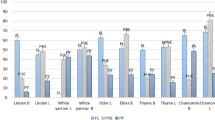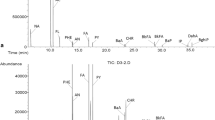Abstract
Orthodox black tea is obtained from fresh leaves followed by withering, rolling, fermentation and drying. The presence of 16 priority polycyclic aromatic hydrocarbons (PAHs) was studied in fresh leaves and at various stages of manufacturing. Benzo(a)pyrene (2A: probable human carcinogen) was found in dried tea leaves only whereas, naphthalene (2B: probable human carcinogen) was present during all the stages of manufacturing. Dry tea leaves showed higher content of total 16 PAHs (∑PAHs) about 3 and 211 times than present in withered and dried leaves, respectively. Chrysene, benzo[g,h,i]perylene, indendo[1,2,3-c,d]pyrene, dibenzo[a,h]pyrene and benzo[a]antracene were not found during manufacturing stages of tea.


Similar content being viewed by others
References
Cai, L. S., Xing, J., Dong, L., & Wu, C. (2003). Application of polyphenylmethylsiloxane coated fiber for solid-phase microextraction combined with microwave-assisted extraction for the determination of organochlorine pesticides in Chinese teas. Journal of Chormatography. A, 1015, 11–21.
Fiedler, H., Cheung, C. K., & Wong, M. H. (2002). PCDD/PCDF, chlorinated pesticides and PAH in Chinese teas. Chemosphere, 46, 1429–1433.
Kumar, V., Tewary, K. K., Ravindranath, S. D., & Shanker, A. (2004). Investigation in tea on fate of fenazaquin residue and its transfer in brew. Food Chemistry and Toxicology, 42, 423–428.
Kurodo, A., & Hara, Y. (1999). Antimutagenic and anticarcinogenic activity of tea polyphenols. Mutation Research, 436, 69–97.
Lin, D., & Zhu, L. (2004). Polycyclic aromatic hydrocarbons: pollution and source analysis of a black tea. Journal of Agriculture and Food Chemistry, 52, 8268–8271.
Lin, D. H., Zhu, L. Z., & Wang, J. (2004). Environmental impact of PAHs on the metal-smelting area of Tangxia, China. Fresenius Environmental Bulletin, 13, 447–453.
Liu, Z., Ma, L. P., Zhou, B., Yang, L., & Liu, Z. L. (2000). Antioxidative effects of green tea polyphenols on free radical initiated and photosensitized peroxidation of human low density lipoprotein. Chemistry and Physics of Lipids, 106, 53–63.
NEERI (National Environmental Engineering Research Institute) (2009). Environmental impact assessment (EIA) study for exploratory drilling of oil exploration in the block PEL of Kangra-Mandi, Himachal Pradesh. http://www.indiaenvironmentportal.org.in/files/eia-oil.pdf. Accessed 9 January 2012.
Schlemitz, S., & Pfannhauser, W. (1997). Supercritical fluid extraction of mononitrated polycyclic aromatic hydrocarbons from tea-correlation with PAH concentration. Zeitschrift fur Lebensmittel- Untersuchung und -Forschung A (Berlin), 205, 305–310.
Singh, S., & Parkash, V. (2007). Toxic environmental releases from medical waster inciration: a review. Environmental Monitoring and Assessment, 132, 67–81.
Singh, S., Vashishth, A., & Vishal (2011). PAHs in some brands of tea. Environmental Monitoring and Assessment, 177, 35–38.
Weisburger, J. H. (1997). Tea and health: a historical perspective. Cancer Letters, 114, 315–317.
Wheeler, D. S., & Wheeler, W. J. (2004). The medicinal chemistry of tea. Drug Development Research, 61, 45–65.
Wong, M. H., Fung, K. F., & Carr, H. P. (2003). Aluminium and fluoride contents of tea, with emphasis on brick tea and their health implications. Toxicology Letters, 137, 111–120.
Acknowledgment
Financial support from University Grants Commission, New Delhi is highly acknowledged.
Author information
Authors and Affiliations
Corresponding author
Electronic supplementary material
Below is the link to the electronic supplementary material.
ESM 1
(DOCX 3558 kb)
Rights and permissions
About this article
Cite this article
Grover, I.S., Singh, S. & Pal, B. Priority PAHs in orthodox black tea during manufacturing process. Environ Monit Assess 185, 6291–6294 (2013). https://doi.org/10.1007/s10661-012-3025-y
Received:
Accepted:
Published:
Issue Date:
DOI: https://doi.org/10.1007/s10661-012-3025-y




